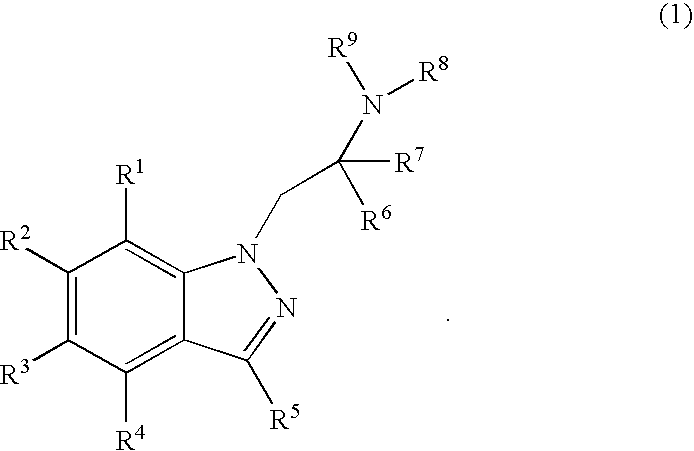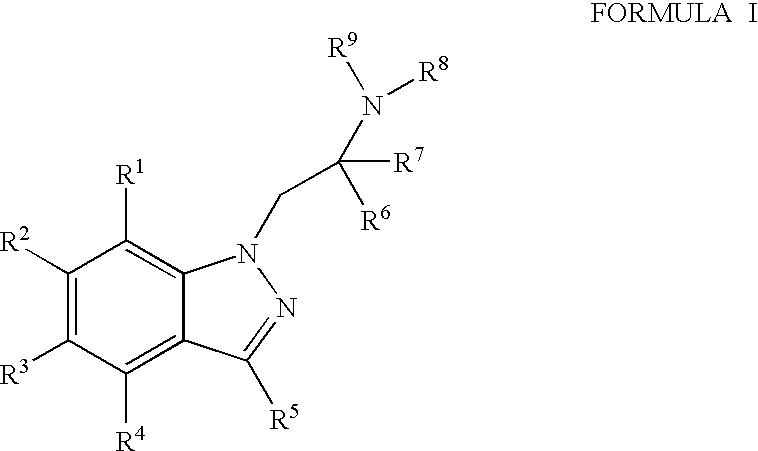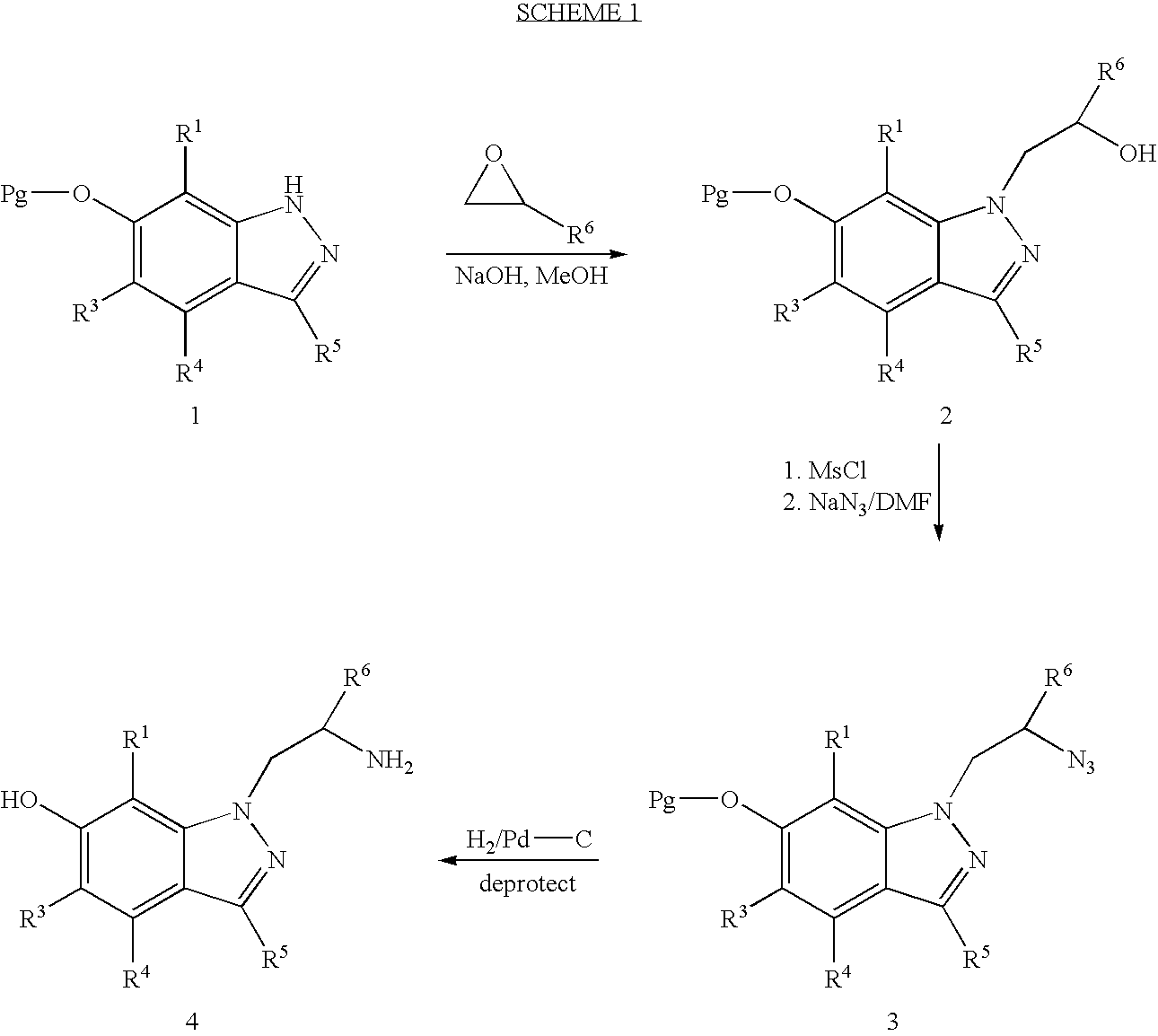6-hydroxy-indazole derivatives for treating glaucoma
a technology of glaucoma and derivatives, applied in the field of6-hydroxy-indazole derivatives for treating glaucoma, can solve the problems of individuals who do not respond well, considered to be a high risk for the eventual development of visual loss, etc., and achieve the effect of reducing and controlling iop
- Summary
- Abstract
- Description
- Claims
- Application Information
AI Technical Summary
Benefits of technology
Problems solved by technology
Method used
Image
Examples
example 1
2-(6-Methoxy-3-methyl-indazol-1-yl)-1-methylethylamine Fumarate
Step A: 6-Methoxy-3-methyl-1H-indazole
[0077]To a solution of 2-fluoro-4-methoxyacetophenone (1.90 g, 11.3 mmol) in ethanol (20 ml) was added hydrazine hydrate (1.4 ml, 45.0 mmol) and heated at reflux temperature for 6 h. This mixture was evaporated to a residue and ethylene glycol (10 ml) was added. The mixture was heated at 150° C. for 18 h, cooled to room temperature, diluted with water (50 ml), and extracted with dichloromethane (3×60 ml). The combined extracts were washed with brine (10 ml), dried (MgSO4) and evaporated to a residue, which was crystallized from ethyl acetate to give a solid (1.1 g, 59%): MS(ES) m / z 163 (M+).
Step B: 1-(6-Methoxy-3-methyl-indazol-1-yl)-propan-2-one
[0078]To a solution of the product from Step A (1.1 g, 6.7 mmol) in DMF (10 ml) was added sodium hydride (60% in oil, 0.41 g, 10.2 mmol) at room temperature. After stirring for 30 min, chloroacetone (0.79 ml, 10.2 mmol) was added, and the sol...
example 2
1-(2-Aminopropyl)-3-methyl-1H-indazol-6-ol Fumarate
Step A: 1-(4-Benzyloxy-2-fluoro-phenyl)-ethanone
[0082]Potassium carbonate (5.5 g, 40.0 mmol) and benzyl bromide (4.6 ml, 38.9 mmol) were added to a solution of 2-fluoro-4-hydroxyacetophenone (5.0 g, 32.4 mmol) in ethanol (50 ml), and the mixture was heated at reflux temperature for 16 h. The reaction mixture was evaporated to a residue to which 2 N HCl (100 ml) was added. This mixture was extracted with ethyl ether (3×60 ml) and the combined extracts were washed with brine (10 ml), dried (MgSO4), and evaporated to a residue, which was crystallized from ethyl acetate (7.4 g, 93%): MS(ES) m / z 245 (M+).
Step B: 6-Benzyloxy-3-methyl-1H-indazole
[0083]A solution of the product from Step A (7.4 g, 30.3 mmol) in ethanol (20 mL) was treated as described for Example 1, Step A to give a colorless solid (6.1 g, 69%): MS(ES) m / z 239 (M+).
Step C: 1-(6-Benzyloxy-3-methyl-indazol-1-yl)-propan-2-one
[0084]A solution of the product from Step B (2.3 g, ...
example 3
2,2-Dimethyl-propionic Acid 1-(2-aminopropyl)-1H-indazol-6-yl Ester Fumarate
Step A: 2,2-Dimethyl-propionic acid 1H-indazol-6-yl Ester
[0088]To a solution of 1H-indazol-6-ol (0.88 g, 6.6 mmol) in dichloromethane (10 ml) at room temperature was added triethylamine (0.98 ml, 7.0 mmol) and DMAP (0.05 g) followed by trimethylacetyl chloride (0.82 ml, 6.6 mmol). After stirring for 1 h, the mixture was diluted with saturated aqueous solution of ammonium chloride (20 ml) and extracted with ethyl acetate (3×50 ml). The combined extracts were washed with brine (10 ml), dried (MgSO4), and evaporated to a residue which was purified by chromatography (silica, 10% to 20% ethyl acetate in hexane) to give an oil (1.1 g, 76%): 1H NMR (CDCl3) δ 8.15 (d, J=0.8 Hz, 1H), 8.01 (s, 1H), 7.75 (s, 1H), 7.58 (d, J=8.6 Hz, 1H), 7.01 and 6.96 (dd, J=2.0 and 8.6 Hz, 1H), 1.59 (s, 9H); MS(ES) m / z 219 (M+).
Step B: 2,2-Dimethyl-propionic Acid 1-(2-oxo-propyl)1H-indazol-6-yl Ester
[0089]A solution of the product of S...
PUM
| Property | Measurement | Unit |
|---|---|---|
| Fraction | aaaaa | aaaaa |
| Fraction | aaaaa | aaaaa |
| Fraction | aaaaa | aaaaa |
Abstract
Description
Claims
Application Information
 Login to View More
Login to View More - R&D
- Intellectual Property
- Life Sciences
- Materials
- Tech Scout
- Unparalleled Data Quality
- Higher Quality Content
- 60% Fewer Hallucinations
Browse by: Latest US Patents, China's latest patents, Technical Efficacy Thesaurus, Application Domain, Technology Topic, Popular Technical Reports.
© 2025 PatSnap. All rights reserved.Legal|Privacy policy|Modern Slavery Act Transparency Statement|Sitemap|About US| Contact US: help@patsnap.com



